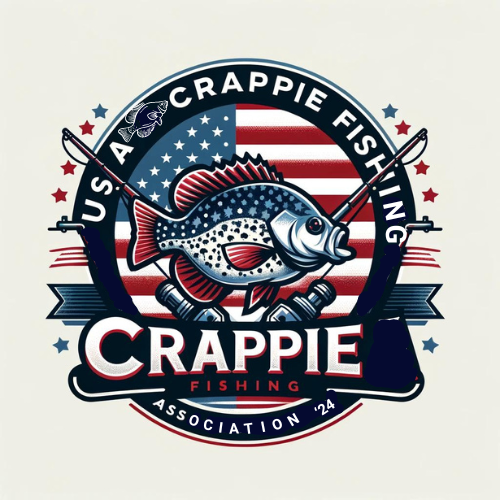“Give a man a fish and you feed him for a day; teach a man to fish and you feed him for a lifetime.” – Confucius
When it comes to fishing, there’s nothing quite like the thrill of casting a line into a serene lake and reeling in a big catch. Lake fishing offers a wide variety of opportunities for anglers, whether you’re exploring the depths of a natural lake or tackling the challenges of a man-made reservoir. Each type of lake presents its own unique set of fishing techniques and strategies that can enhance your chances of success.
In this article, I will guide you through the top lake fishing techniques for anglers. From fishing in natural lakes to strategies for man-made reservoirs, I will provide you with valuable tips and insights to improve your fishing skills and increase your chances of landing that prized catch.
So, grab your fishing gear, put on your favorite hat, and let’s dive into the world of lake fishing!
Key Takeaways:
- Lake fishing provides a thrilling experience and a chance to catch big fish.
- There are different techniques for fishing in natural lakes and man-made reservoirs.
- Understanding the characteristics of each type of lake is key to successful fishing.
- Choosing the right fishing setups, equipment, and locations can significantly improve your chances of success.
- Fishing from a boat offers advantages such as access to deeper water and the ability to cover more ground.
Tips for Fishing in Natural Lakes
When fishing in natural lakes, there are certain tips and techniques that can significantly improve your success rate. By understanding the unique characteristics of natural lakes and tailoring your approach accordingly, you can increase your chances of landing that prized game fish. Here are some valuable tips:
1. Find Areas with Vegetation
Look for areas in the lake that have vegetation such as lily pads and reeds. These areas provide valuable cover for game fish like largemouth bass and northern pike. Additionally, vegetation-rich areas tend to have higher oxygen levels, which attract and sustain fish populations.
2. Utilize Weedless Spoons
When fishing around vegetation, it’s essential to use lures that won’t get tangled or caught in the weeds. Weedless spoons are specifically designed to glide smoothly through the vegetation without snagging. They mimic the movement of injured baitfish and are highly effective in attracting predatory fish.
3. Target Areas with Structure
If the lake doesn’t have much vegetation, focus on areas with logs or rock piles. These structures provide hiding spots for fish and create a diverse underwater habitat. When fishing around logs or rock piles, it’s advisable to use heavier leader material to withstand the potential rough surfaces.
4. Increase Your Chances of Success
Finding natural lakes that offer both vegetation and structure increases your chances of success. Remember, different types of game fish have different preferences, so it’s essential to research the specific species you’re targeting and their preferred habitats within natural lakes.
| Advantages | Disadvantages |
|---|---|
| 1. Ample cover and oxygen levels | 1. Vegetation and structure can be challenging to navigate |
| 2. Attracts diverse fish populations | 2. Fishing spots may be more competitive |
| 3. Opportunities to target game fish species | 3. Requires knowledge of fish behavior and lake topography |
| 4. Fishing in a natural and pristine environment | 4. Potential for snags and tangles in vegetation and structure |
By applying these tips when fishing in natural lakes, you’ll be well on your way to a successful angling experience. Whether you’re targeting largemouth bass or northern pike, understanding and utilizing the unique features of natural lakes can make all the difference in your quest for that trophy catch.
Strategies for Fishing in Man-Made Lakes
Fishing in man-made lakes, such as reservoirs and pits, requires a different approach. These lakes offer unique challenges and opportunities that anglers should be aware of. By understanding the characteristics of man-made lakes and adjusting your fishing techniques accordingly, you can significantly improve your success rate.
One important consideration when fishing in man-made lakes is the fluctuating water levels. These lakes often experience water level changes due to factors such as dam releases or irrigation needs. As a result, fish in man-made lakes tend to utilize drop-offs, creek edges, and ledges for food and cover. It is crucial to target these areas when fishing.
To effectively fish in man-made lakes, consider using a 3-way swivel rig. This rig consists of a mainline attached to a 3-way swivel, with a weight and leader line connected to the other two swivels. The weight keeps the baited hook near or on the bottom of the lake, where fish are commonly found.
When casting in man-made lakes, focus on the drop-offs and ledges. These areas often attract fish looking for food or seeking shelter. By casting parallel to these structures, you increase your chances of enticing a strike.
Remember to adjust your fishing techniques based on the specific characteristics of the man-made lake you’re fishing in. Each lake may have its own unique features and fish behavior, so experimentation and observation are key to success.
| Factors | Man-Made Lakes | Natural Lakes |
|---|---|---|
| Water levels | Fluctuating | Stable |
| Structure | Drop-offs, creek edges, and ledges | Aquatic vegetation, logs, rock piles |
| Fish behavior | Utilize drop-offs and ledges | Seek vegetation and structure |
| Recommended techniques | 3-way swivel rig, casting along drop-offs | Fishing around vegetation or structure |
Understanding the differences between man-made lakes and natural lakes can guide your fishing approach in each environment. By implementing these strategies and adapting to the unique characteristics of man-made lakes, you’ll increase your chances of a successful fishing trip.
Basic Lake and Pond Fishing Setups
When it comes to lake and pond fishing, there are three basic setups that every angler should be familiar with: cast and retrieving, fishing off the bottom, and suspended bobber and bait fishing. Each setup offers its advantages and can be tailored to suit different fishing techniques and preferences.
Cast and Retrieving Setup
The cast and retrieving setup involves continually casting and retrieving a lure, such as a spinner or spoon, to entice fish to strike. This technique is effective for covering a large area of water and enticing fish that are actively feeding or chasing prey. The key is to vary your retrieval speed and presentation to mimic the behavior of the fish’s natural prey.
Fishing off the Bottom
Fishing off the bottom is a popular technique for targeting fish that prefer to feed near or on the lake or pond bottom. To set up this fishing setup, you will need a 3-way swivel, weight, leader line, and bait. The weight keeps your bait near the bottom while the leader line allows for natural and free movement. This setup is ideal for species like catfish, carp, and bottom-feeding species.
Suspended Bobber and Bait Fishing
If you prefer fishing with a bobber, the suspended bobber and bait fishing setup is perfect. This setup involves using a bobber, split shots, hook, and bait to suspend your lure at a chosen depth. The bobber serves as an indicator when a fish takes the bait, allowing for timely hooksets. This technique works well for targeting species like bluegill, crappie, and other panfish.
Remember, these setups can be combined or modified based on your fishing preferences and the specific conditions of the lake or pond you are fishing. By experimenting with different setups and techniques, you can increase your chances of success and enjoy a fulfilling fishing experience.
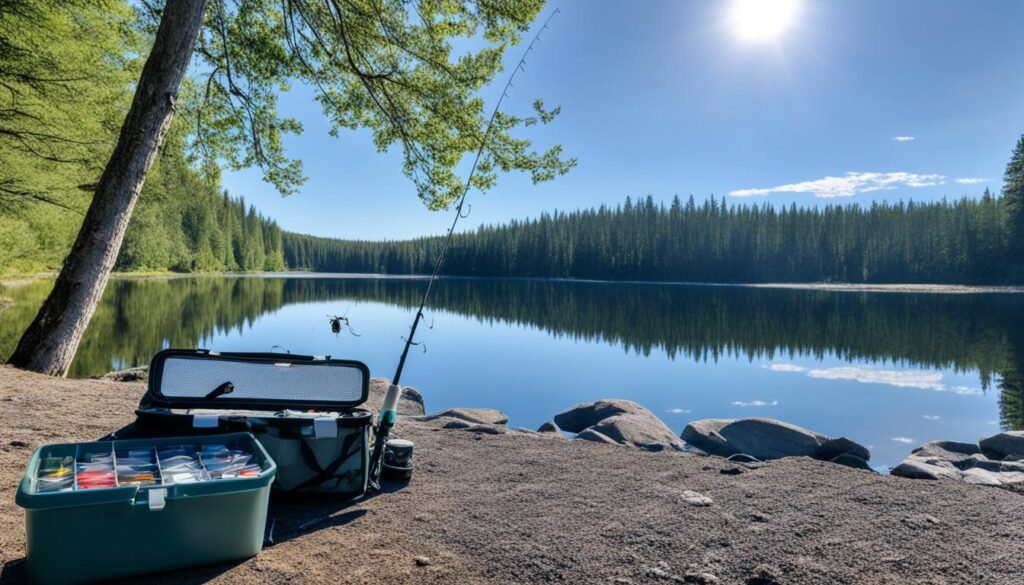
The Benefits of Using a Boat for Lake Fishing
Fishing from a boat offers numerous advantages that can enhance your fishing experience. Whether you are an experienced angler or a beginner, utilizing a boat provides unique opportunities to maximize your success on the water. Here are some key benefits of fishing from a boat:
Cover More Water
One of the primary advantages of fishing from a boat is the ability to cover a larger area of water. Unlike fishing from the shore, a boat allows you to explore different parts of the lake, increasing your chances of finding fish. By moving around, you can locate productive fishing spots and adjust your strategy accordingly.
Reach Distant Spots
With a boat, you have the freedom to reach distant spots that are inaccessible from the shore. This opens up a whole new world of fishing opportunities. Whether it’s a secluded cove, a hidden inlet, or a hotspot on the other side of the lake, a boat allows you to explore and fish in areas that are not easily reachable by foot.
Access Deeper Water
Fishing from a boat enables you to access deeper water where larger fish often reside. By venturing into deeper areas of the lake, you increase your chances of hooking trophy-sized fish. Deeper water provides a cooler and more comfortable environment for fish, particularly during hot summer months.
Troll for Success
Using a boat allows you to employ trolling techniques, which can be highly effective for targeting fish that feed on smaller baitfish. Trolling involves trailing lures or baits behind a moving boat, creating the illusion of a fast-moving prey. This method increases your chances of enticing predatory fish and can yield impressive catches.
Position Yourself Strategically
A boat provides the flexibility to position yourself in advantageous locations on the water. You can anchor or drift near structures, drop-offs, or popular feeding areas to maximize your chances of catching fish. By choosing the right spot, you can target specific species and increase your overall fishing success.
Choose the Right Boat
When it comes to fishing from a boat, it’s essential to choose the right type of vessel for your specific needs. Canoes, skiffs, jonboats, and other types of boats each have their own advantages and are suitable for different water bodies and fishing tasks. Consider factors such as stability, maneuverability, and storage capacity to ensure you select the best boat for your fishing adventures.
Fishing from a boat offers a range of advantages that can significantly enhance your angling experience. Whether you seek to explore new fishing spots, cover more water, or access deeper areas, a boat provides the means to elevate your fishing game. Consider your fishing needs and the type of water you’ll be fishing in when choosing a boat, and get ready to enjoy the many benefits it brings to your fishing adventures.
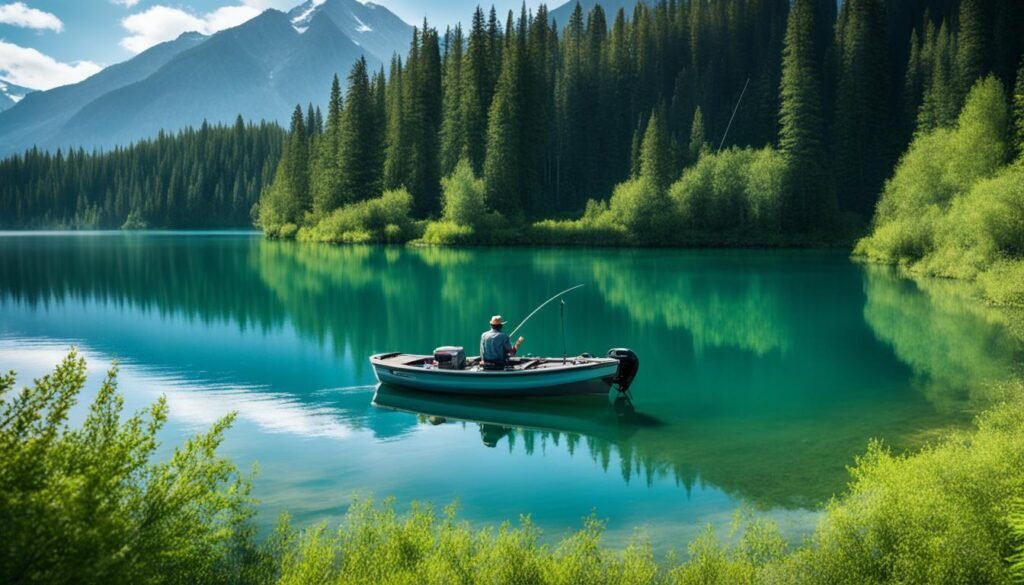
Trolling: an Effective Fishing Technique
Trolling is a highly effective fishing technique that involves trailing lures or baits behind a slowly running boat, covering a large area of water. This method is particularly successful in targeting species that feed on smaller fish, allowing anglers to entice and catch their desired catch.
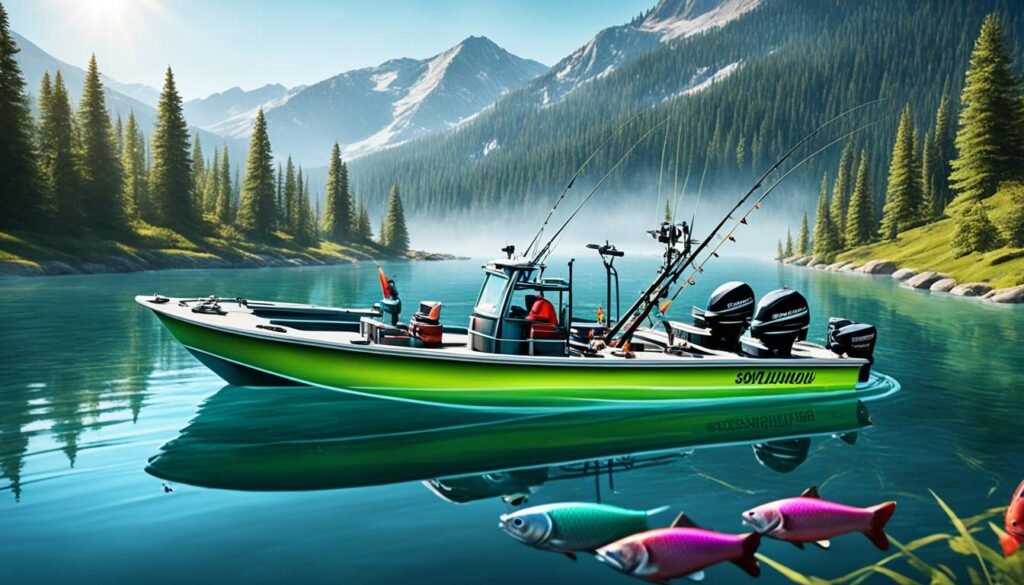
Trolling provides anglers with the opportunity to explore various depths and areas of a water body, increasing the chances of encountering active fish. By continuously moving the bait, you can mimic the movement of a real prey, enticing predatory fish to strike.
Trolling Tips for Success
- Choose the right lures: Select lures that resemble the preferred prey of the target fish species. Vibrantly colored spoons, crankbaits, or soft plastic swimbaits are commonly used for trolling.
- Vary your speed: Experiment with different trolling speeds to find the optimal pace at which fish are most actively biting. Faster speeds are usually effective for targeting species like mackerel or tuna, while slower speeds work well for largemouth bass or walleye.
- Utilize downrigging: Downrigging is a popular trolling method that involves the use of a winch and weight to position your bait at a specific depth where fish are actively feeding. This technique allows you to effectively target fish at different water depths.
- Pay attention to depth: Use a fish finder or depth sounder to identify underwater structures, drop-offs, or changes in depth where fish are likely to congregate. Adjust the depth of your bait accordingly for maximum effectiveness.
- Experiment with lure presentation: Vary the distance between your lure and the boat, as well as the amount of line you let out. Changing the depth at which your lure runs can help you target fish at different levels in the water column.
“Trolling allows anglers to cover a larger area of water and present their bait in a realistic manner, increasing the chances of enticing fish to strike.”
Trolling is a versatile and enjoyable fishing technique that can be used in both freshwater and saltwater environments. It offers anglers the opportunity to explore different areas of a water body, adapt to changing fish behavior, and target a wide range of fish species.
Still Fishing: a Simple and Effective Approach
When it comes to fishing techniques, still fishing is the most basic and straightforward method. It involves casting your bait and keeping it stationary, allowing the fish to come to you.
Still fishing is particularly effective when done from a boat, as it allows you to position yourself in favorable locations where there is a higher chance of finding fish. This technique is great for beginners who are just starting their fishing journey.
To set up for still fishing, you’ll need a few basic components. The primary equipment includes a rod and reel, a baited hook, weighted line, and optionally, a colorful bobber. The bobber serves as a visual indicator when a fish bites, alerting you to the action.
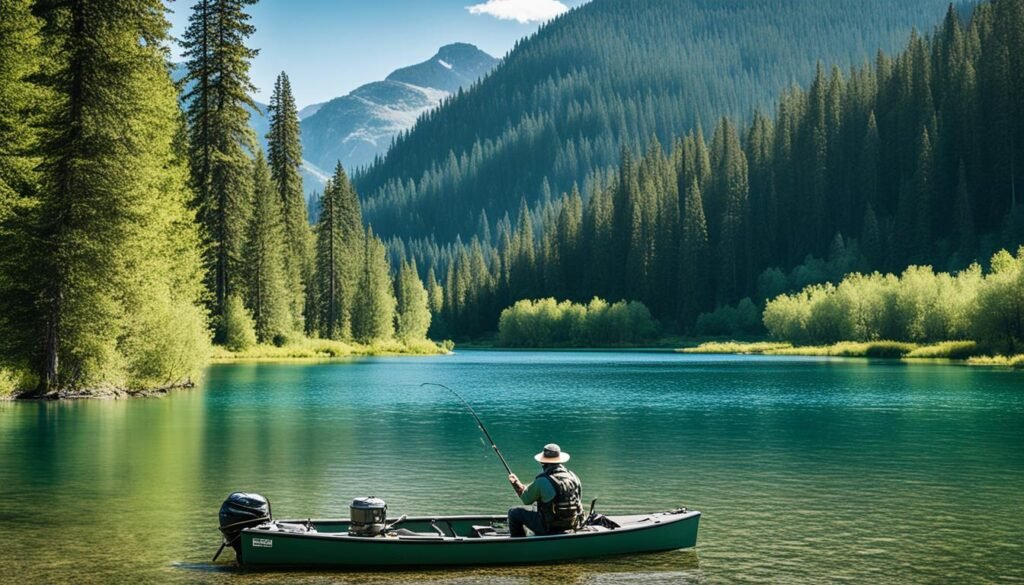
When selecting your bait, consider using options that are known to attract the type of fish you’re targeting. Live bait, such as worms or minnows, or artificial bait, like soft plastics or jigs, can be effective choices.
Now that you have your gear and bait ready, it’s time to find strategic spots to fish. Look for areas with cover, such as submerged vegetation or fallen trees, as they provide hiding places for fish. Also, consider the water depth and temperature, as different species have preferred habitats.
Remember to be patient and give the fish time to investigate your bait. Maintain a steady hand and avoid unnecessary movements, as any sudden vibrations can scare the fish away.
Still fishing allows you to relax and enjoy the tranquility of the water while waiting for the fish to take the bait. It’s a great opportunity to connect with nature and appreciate the beauty of the outdoors.
In conclusion, still fishing is a simple and effective technique that can be mastered by beginners and experienced anglers alike. With the right equipment, bait selection, and strategic positioning, you’ll increase your chances of success on your next fishing trip.
Flipping and Pitching: Techniques for Precise Casting
Flipping and pitching are essential casting techniques that anglers use in specific situations, such as fishing in dirty water or thick cover. These techniques require accuracy, delicacy, and precise casting to make quiet presentations and place the lure exactly where the fish are hiding.
Flipping: Flipping involves releasing a short amount of line while feeding it back through the guides of the fishing rod. This technique allows for close-range and precise casting, making it ideal for targeting fish in tight spaces like vegetation, docks, or fallen trees.
Pitching: Pitching is another technique used to cast the lure accurately and quietly. It involves an underhand pitching motion to release the lure and deliver it to a specific location. Pitching is effective when casting to targets slightly farther away, such as isolated cover or shallow structures.
Both flipping and pitching techniques require specialized equipment to achieve the desired results. Anglers commonly use flipping sticks, which are heavy and have extra length, for enhanced control and leverage during these precise casts. The longer rod allows for better line control, improved accuracy, and the ability to make longer casts if necessary.
Benefits of Flipping and Pitching:
- Accurate and quiet presentations: Flipping and pitching techniques enable anglers to present their lure stealthily and accurately, increasing the chances of enticing and hooking fish.
- Precision casting: These techniques allow anglers to place the lure in tight spaces or close to specific targets where fish tend to hide, increasing the likelihood of triggering a strike.
- Effective in challenging conditions: Flipping and pitching excel in situations with dirty water, heavy cover, or when avoiding spooking fish is crucial. By avoiding loud splashes and disturbances, anglers have a better chance of fooling wary fish.
Mastering flipping and pitching techniques takes practice and experience. Learning to control and feather the line, judging distance, and honing your accuracy are key aspects of refining these casting techniques. With time and effort, you’ll become proficient in casting precisely and securing successful catches in challenging fishing scenarios.
Expert Tip:
“When flipping and pitching, it’s crucial to pay attention to your surroundings. Observe where fish might be hiding, target areas with cover or structure, and practice your accuracy to ensure your lure lands subtly and precisely in their strike zone.” – John Smith, Professional Angler
Fly Fishing: an Artful and Rewarding Experience
Fly fishing is a specialized angling method that uses artificial flies, which imitate insects or animals, to attract and catch fish. It is a popular technique for targeting trout and salmon, but it can be applied to a variety of other species. Fly anglers often use small boats, such as kayaks or canoes, to access remote locations and achieve precise presentations. Fly fishing requires specific gear, including fly rods and lines, and mastering the casting technique to achieve accurate and delicate presentations.
Fly fishing is not just a means to catch fish; it is an art form that requires patience, skill, and an understanding of the natural world. The deliberate and graceful casting of the fly line, the delicate presentation of the fly on the water’s surface, and the anticipation of a strike are all part of the appeal of fly fishing.
Fly Fishing Techniques
There are various fly fishing techniques used to entice fish to strike the artificial fly. Some common techniques include:
- Dry Fly Fishing: This technique involves casting a buoyant fly that imitates an insect floating on the water’s surface. Anglers use delicate presentations and precise casting to fool fish into thinking the fly is a real insect.
- Nymph Fishing: Nymphs are subsurface forms of aquatic insects. With this technique, anglers use weighted flies or small indicators to fish nymph patterns below the water’s surface, mimicking the natural behavior of insects as they transition from aquatic life to the adult stage.
- Streamers: Streamers imitate small baitfish or other aquatic prey. Fly anglers use retrieve techniques that mimic the movement of injured or fleeing prey to entice aggressive strikes from larger fish.
Fly selection is crucial in fly fishing, as different fly patterns imitate specific insects or prey items that fish are actively feeding on. Understanding the local insect hatches and matching the hatch with the appropriate fly pattern can greatly increase angler success.
“Fly fishing is not just a hobby, it’s a way of life. The connection to nature and the thrill of fooling a fish on an intricately tied fly is unmatched. A successful day on the water is not solely measured by the number of fish caught but by the overall experience and connection with the environment.” – John Anderson, Fly Fishing Enthusiast
Fly Fishing for Trout
Trout are one of the most sought-after species in fly fishing. They are known for their elusive nature and voracious feedings habits, making them an exciting challenge for anglers. To effectively fly fish for trout, it is important to:
- Understand the trout’s feeding habits, preferred habitats, and seasonal behaviors.
- Match the hatch by selecting fly patterns that imitate the insects or prey items trout are actively feeding on.
- Explore different water types, including riffles, runs, pools, and undercut banks, as trout often occupy specific areas within a river or stream.
- Utilize various casting techniques, such as the roll cast, reach cast, and mending, to achieve accurate and effective presentations to trout.
| Essential Gear | Optional Gear |
|---|---|
| Fly rod and reel combo | Fly tying materials |
| Fly line | Fly fishing vest |
| Fly leaders and tippets | Fly floatant |
| Assorted flies | Landing net |
| Fly box | Polarized sunglasses |
Finding the Best Times and Seasons for Fishing
The best times and seasons for fishing can greatly impact your success on the water. Various factors, including environmental conditions, species behavior, and angling techniques, play a role in determining the optimal times to fish. Understanding these elements will guide you in planning your fishing trips and increase your chances of landing a great catch.
Best Times of Day to Fish
Typically, freshwater fish are more active during specific periods of the day. Early morning, shortly after dawn, and late afternoon, during dusk, are prime times for fishing. Fish tend to be more active during these hours as they are feeding and searching for prey. It’s when they are most likely to bite. Additionally, during Noon and the early afternoon, fish activity tends to decrease due to higher water temperatures and sunlight intensity.
Species-specific Habits
Understanding the habits and patterns of different fish species can help you determine the best times to target them. For example, bass are known to be more active in the early morning and late afternoon, while catfish are more active at night. Researching the behavior and feeding habits of the specific species you are targeting will give you valuable insights into when they are most likely to be active.
Seasonal Considerations
Seasonal changes also play a significant role in fish behavior. Water temperature, daylight length, and food availability vary throughout the year, affecting fish activity and feeding patterns. In colder months, fish tend to be less active and may move to deeper, warmer waters. During spawning seasons, certain species may be less likely to bite as they focus on reproduction. Understanding the seasonal variations in your fishing area will help you adjust your strategies accordingly.
Regulatory Restrictions
It’s important to be aware of any local fishing regulations that can affect when and where you fish. Some fishing areas may have specific seasons or time restrictions in place to protect vulnerable fish populations. These regulations are designed to sustain healthy ecosystems and prevent overfishing. Familiarize yourself with the local fishing regulations and ensure you comply with them to promote sustainable fishing practices.
By considering the best times and seasons for fishing, you can maximize your chances of success on the water. Whether you prefer early morning sessions or twilight fishing adventures, being attuned to environmental factors, fish behavior, and regulatory requirements will help you plan your fishing trips effectively.
Key Takeaways:
- Freshwater fish are more active after dawn and at dusk, while activity decreases during Noon and early afternoon.
- Understanding the habits and availability of different fish species can guide you in choosing the right times to fish.
- Seasonal variations in water temperature, daylight, and food availability affect fish behavior.
- Local fishing regulations may impose restrictions on certain periods to protect fish populations.
Factors to Consider for Successful Fishing
Several factors contribute to successful fishing, including understanding fish behavior, environmental conditions, and choosing the right approach, techniques, and equipment.
Fish behavior is influenced by various factors, such as hiding areas, salinity, dissolved oxygen, water temperature, food availability, and water depth. Different fish species have specific habitat preferences and feeding habits, which should be taken into account when planning a fishing trip.
By understanding fish behavior, anglers can determine the most effective methods and locations for catching fish. For example, if targeting largemouth bass, it is important to identify their preferred hiding areas such as aquatic vegetation or submerged structures like fallen trees. In contrast, species like trout may be found in cold, fast-flowing streams or deep pools.
To increase fishing success, environmental conditions must also be considered. Factors such as weather, water clarity, and seasonal changes can significantly impact fish behavior and feeding patterns. For instance, fish may be more active during cooler temperatures or anglers may have better luck fishing after a rainfall when fish are more likely to be feeding near the surface.
“Understanding fish behavior and environmental conditions is crucial for choosing the right fishing techniques and equipment.”
Choosing the right approach and techniques is another key factor in achieving fishing success. Different fishing methods, such as casting and retrieving, still fishing, trolling, flipping, or fly fishing, are suited for specific situations and target different fish species.
Opting for the appropriate equipment, including rods, reels, lines, and lures, based on the target species and fishing method is essential. For example, lighter tackle and smaller lures may be suitable for trout fishing, while heavier gear and larger baits may be needed for muskie or saltwater fishing.
Overall, understanding fish behavior, considering environmental conditions, and selecting the right approach, techniques, and equipment are key factors to maximize fishing success. By applying this knowledge and adapting to the specific fishing conditions, anglers can increase their chances of catching their desired fish species.
Now, let’s take a look at a table summarizing these factors:
| Factors | Description |
|---|---|
| Understanding fish behavior | Identify preferred habitats, feeding habits, and hiding areas of target fish species. |
| Environmental conditions | Consider weather, water temperature, clarity, and seasonal changes to adapt fishing techniques accordingly. |
| Choosing the right approach | Select the most suitable fishing method, such as casting and retrieving, still fishing, trolling, flipping, or fly fishing. |
| Choosing the right techniques | Employ appropriate fishing techniques based on the target fish species and fishing conditions. |
| Choosing the right equipment | Opt for the appropriate rods, reels, lines, and lures specific to the target species and fishing method. |
Conclusion
Fishing is a diverse and rewarding activity that offers anglers a wide range of techniques and approaches. Whether you prefer lake fishing from the shore or a boat, in natural or man-made lakes, there are always opportunities to catch fish. By understanding the characteristics of different types of lakes, using the appropriate setups and gear, and considering environmental factors, you can greatly increase your chances of success.
Continuous learning and experience are key to improving your fishing skills. Take the time to familiarize yourself with the specific techniques and strategies for fishing in natural lakes or man-made lakes. Experiment with different setups and lures to find what works best for you. Remember, fishing is an art that requires patience, observation, and adaptation.
As with any outdoor activity, respecting nature and practicing responsible fishing are essential. Be aware of regulations, catch and release practices, and the conservation of fish populations. By being mindful of the environment and practicing sustainable fishing techniques, future generations will also be able to enjoy the wonders of this beloved pastime.
So, get out there and enjoy the thrill of the catch! Whether you’re a seasoned angler or just starting out, fishing provides endless opportunities for relaxation, fun, and the joy of connecting with nature. Embrace the adventure, soak up the beauty of your surroundings, and always remember to respect and conserve our precious waterways. Happy fishing!
